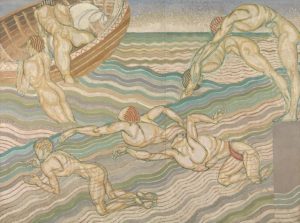The work I have chosen to talk about is Duncan Grant ‘Bathing’ 1911. It depicts a scene of seven naked men diving into the sea, however it has been suggested it is a representation of a continuous movement of a single man diving into the sea.
The focus on male nudity has been argued that it was due to Grants homosexuality and therefore his attraction to males. This art piece was created in the wake of the French post-impressionist movement. The Post-Impressionist movement used a lot of arbitrary and unnatural colours as well as emphasised on geometric forms. You can see that this image was heavily influenced by Post-Impressionism with the unnatural colours and geometric forms of the sea.
Grant was also a member of the Bloomsbury group, which was a group of individuals with mixed fields of work such as: English writers, intellectuals, philosophers and artists. Their works and outlook deeply influenced literature, aesthetics, criticism, and economics as well as current attitudes towards feminism, pacifism, and sexuality. I strongly feel this artwork as well as some of his other works he created around the same time such as ‘Football’ 1911, made a positive impact on societies views on same sex attraction at the time and would have aided the more accepting view of the LGBTQ+ community of today.

